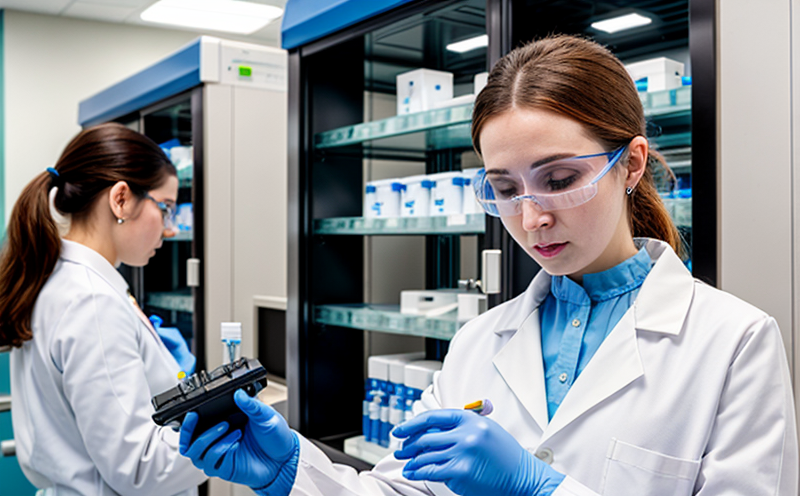Tandem Mass Spectrometry Bioanalysis Testing
In the realm of pharmaceutical testing, bioanalytical testing is a critical component ensuring drug safety and efficacy. Tandem mass spectrometry (MS/MS) is one such advanced analytical technique that has revolutionized this area by providing unparalleled specificity and sensitivity in detecting trace levels of compounds within biological matrices.
At its core, tandem MS/MS bioanalysis involves two stages: the first stage ionizes a sample to generate ions, followed by a second stage where these ions are fragmented. This fragmentation allows for unique fragment ion patterns that can be used as fingerprints or signatures to identify specific compounds with high confidence. This dual-stage process is particularly advantageous in complex biological matrices like blood, urine, plasma, and tissue extracts.
The primary purpose of Tandem MS/MS bioanalysis testing is to accurately quantify drug concentrations in vivo, monitor the pharmacokinetics (PK) profile, evaluate drug interactions, and assess therapeutic drug monitoring. It also plays a crucial role in identifying metabolites, confirming structural integrity, and detecting impurities or degradants.
The equipment used for this testing includes sophisticated mass spectrometers capable of handling various sample types. These instruments are paired with advanced chromatography systems to separate analytes based on their chemical properties before they enter the mass spectrometer for analysis.
For accurate and reliable results, it is essential that samples undergo rigorous preparation steps which may include extraction methods such as liquid-liquid or solid-phase microextraction (SPME), derivatization when necessary, and clean-up procedures to remove matrix interferences. The choice of extraction method depends largely on the nature of the analyte and its stability in different solvents.
The process typically begins with sample collection followed by thorough quality control checks. Samples are then prepared according to standard operating procedures (SOPs) before being analyzed using tandem MS/MS techniques. After acquisition, data processing involves alignment, calibration, quantification, and qualification steps ensuring precise measurement of the target analytes.
Given its precision, accuracy, and ability to detect minute quantities, Tandem MS/MS has become indispensable in pharmaceutical R&D, quality assurance, regulatory compliance, and clinical trials. It supports early-stage research through late-stage development phases by providing robust PK data which is vital for understanding how a drug behaves within the human body.
Standard operating procedures (SOPs) are strictly followed to maintain consistency across all laboratory analyses ensuring that results meet stringent quality standards set forth by regulatory bodies such as FDA, EMA, and ICH. Compliance with international guidelines like ISO/IEC 17025 ensures laboratories deliver accurate, reproducible data.
| Industry Applications | Description |
|---|---|
| Detecting drug metabolites | Identifying the breakdown products of a parent compound to understand metabolism pathways and potential toxicity issues. |
| Quantifying drug concentrations | Monitoring the amount of active ingredient present in a patient’s system over time, which is crucial for determining appropriate dosages. |
| Evaluating drug interactions | Determining whether two or more drugs interfere with each other when taken together, potentially leading to adverse effects. |
- Pharmacokinetics (PK) profiling
- Therapeutic Drug Monitoring (TDM)
- Identification of impurities and degradants in drug substances or formulations
- Metabolite identification and quantification
- Assessment of bioavailability and bioequivalence studies
Scope and Methodology
Tandem MS/MS bioanalysis testing encompasses a wide range of applications within pharmaceutical development and quality assurance processes. The scope includes not only the qualitative identification but also the quantitative determination of various analytes in biological samples.
The methodology involves several key steps starting from sample collection, followed by extraction procedures tailored to specific matrices like plasma or urine. Post-extraction, clean-up methods are employed to eliminate interfering components before introducing the sample into the mass spectrometer.
During actual analysis, ions generated from the first stage of the tandem MS/MS are subjected to fragmentation under controlled conditions producing characteristic fragment ions. These fragments serve as signatures allowing for unambiguous identification and quantification of the analyte.
Data acquisition is followed by rigorous data processing which includes peak alignment, calibration curve generation, and statistical analysis. All these processes contribute towards generating reliable quantitative results that form the basis for decision-making in drug development projects.
| Acceptance Criteria | Description |
|---|---|
| Ruggedness of quantitation | The ability to consistently deliver accurate and precise measurements across multiple runs and operators. |
| Limits of detection (LOD) | The minimum amount of analyte that can be reliably detected by the method. |
| Linearity range | The concentration interval over which calibration standards yield linear responses in terms of signal intensity versus analyte concentration. |
| Repeatability and reproducibility | Measurements made under identical conditions should give the same or very similar results. |
Industry Applications
Tandem MS/MS finds extensive application across diverse segments within pharmaceutical testing. Here are some key areas:
- Detecting drug metabolites to understand metabolism pathways and potential toxicity issues.
- Quantifying drug concentrations in vivo to monitor the amount of active ingredient present over time, essential for determining appropriate dosages.
- Evaluating drug interactions by determining whether two or more drugs interfere with each other when taken together, potentially leading to adverse effects.
| Use Cases and Application Examples | Description |
|---|---|
| Pharmacokinetics (PK) profiling | Assessing the rate and extent of absorption, distribution, metabolism, and excretion of a drug. |
| Therapeutic Drug Monitoring (TDM) | Maintaining therapeutic concentrations of drugs in patients’ systems to avoid toxicity or subtherapeutic levels. |
| Identification of impurities and degradants | Determining the presence of unwanted substances that could affect drug efficacy or safety. |
| Metabolite identification and quantification | Analyzing breakdown products to better understand metabolic processes. |





